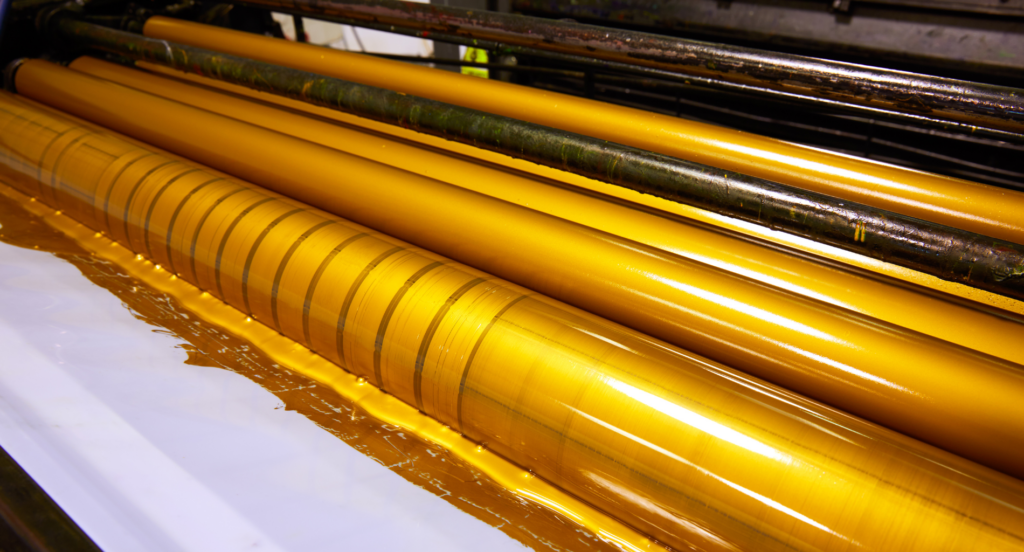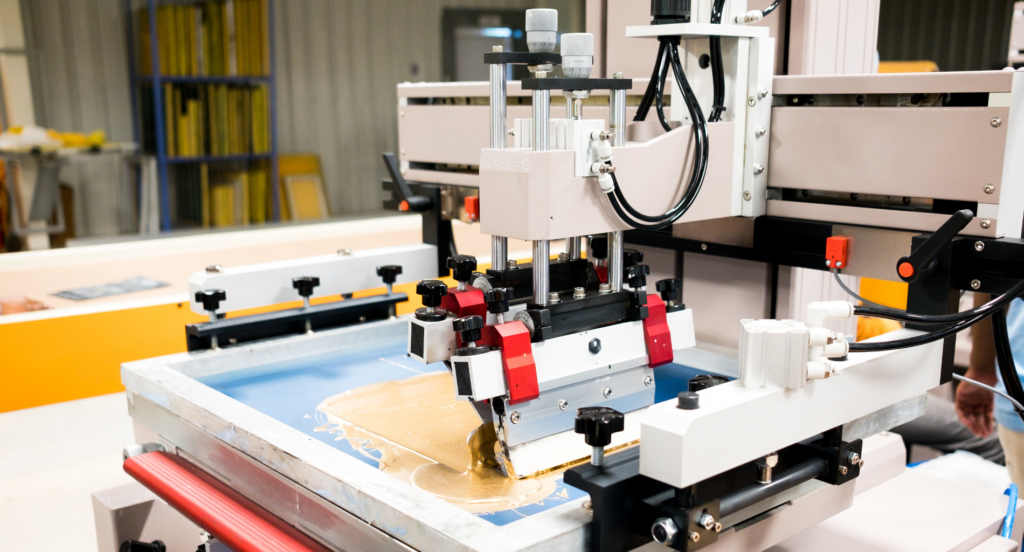What is silk screen printing? It’s a process that uses a mesh screen to transfer ink onto various materials, including metals, to create patterns or designs.
As a Textile Designer, I often get asked about how silk screen printing works and why it’s such an effective technique for creating detailed designs on different surfaces.
Don’t worry, silk screen printing is a simple process once you understand the basics.
In this guide, you will learn about the materials used, how the process works, and why it’s a popular choice for applying designs in different industries.
Let’s get started!
1. Understanding the Silk Screen Printing Process
Silk screen printing is a fascinating process that combines precision, creativity, and technical skill. In metal fabrication, this process is adapted to apply specially formulated inks or coatings onto metal surfaces. This technique allows for the creation of intricate designs and patterns with a high degree of accuracy.
The beauty of silk screen printing in metal fabrication lies in its versatility and adaptability. The inks used are resistant to environmental factors like moisture and sunlight, ensuring that the designs remain vibrant and intact over time. This process is ideal for producing high-quality, durable signage, decorative panels, and branded metal components.

2. Types of Silk Screen Printing
Silk screen printing on metal offers a variety of techniques, each with its unique applications and results. These techniques provide versatility in design and functionality for metal fabrication. Here are three key types:
Flat-Bed Screen Printing
According to Auto Print Machine, flat-bed screen printing is the traditional form of silk screen printing, ideal for printing on flat metal surfaces. In this process, the screen is placed directly above the substrate, and the ink is applied using a squeegee in a sweeping motion. This method is known for its precision and is perfect for creating high-detail images or designs on metal sheets.

Rotary Screen Printing
Rotary screen printing is designed for high-volume, continuous patterns and is often used in industrial applications. At Zemetal, this method involves a cylindrical screen that rotates in a fixed position as the substrate moves through the machine. Rotary screen printing is highly efficient for large-scale production, making it suitable for producing uniform patterns on long rolls of metal or continuous metal sheets.

Digital Screen Printing
Digital screen printing represents the modern evolution of traditional silk screen printing, incorporating digital technology to enhance precision and versatility. This method uses a digital printer to directly apply ink onto the metal surface, allowing for more complex and multi-colored designs. Digital screen printing is ideal for producing detailed and vibrant images, often used in creating bespoke metal artwork, and custom signage.

3. Tools and Materials Used in Silk Screen Printing
After discussing the types of silk screen printing, it’s crucial to understand the tools and materials that make these processes possible. Here are the essential tools and materials involved in silk screen printing:
Tools
- Screens and Frames: These are fundamental to the silk screen printing process. The screens, made of finely woven fabric stretched over a frame, are what the ink passes through to create the design.
- Squeegees: A squeegee is used to evenly spread ink across the screen, ensuring that it passes through the mesh and onto the metal surface uniformly.
- Exposure Units: These units are used to harden the photo-sensitive emulsion applied on the screen, which forms the stencil for the design. This process is crucial for creating detailed and precise designs on the metal.
Materials
- Photo-sensitive Emulsion: Applied to the screen, this emulsion hardens upon exposure to light in the pattern of the design, creating a stencil for the ink to pass through.
- Inks: Special inks are used for silk screen printing on metal, chosen for their adherence to metal surfaces and durability under various conditions.
- Substrates (Metal Surfaces): Various types of metal surfaces act as substrates in silk screen printing, including stainless steel, and brass, each providing different qualities and finishes to the printed design.
4. The Process of Silk Screen Printing
Following our discussion of the necessary tools and materials, the actual process of silk screen printing on metal is a meticulous and creative journey. Below are the detailed steps involved in the silk screen printing process:
Step#1 Design Creation and Screen Preparation
The journey begins with the creation of a unique design, tailored to the specific needs of the project. This design is meticulously transferred onto a silk screen, which has been coated with a light-sensitive emulsion. This preparation is crucial as it sets the foundation for a precise stencil that will define the print’s quality and accuracy.
Step#2 Exposure and Washing
Next, the screen undergoes an exposure process. It’s exposed to a strong light source, which hardens the emulsion except in the areas blocked by the design. This selective hardening is what creates the stencil. After exposure, the screen is carefully washed. The unhardened emulsion washes away, leaving behind a clear, detailed stencil that matches the original design.
Step#3 Ink Application
With the stencil ready, the screen is then aligned over the metal substrate. Specialized ink, chosen for its compatibility with metal, is applied over the screen. A squeegee is skillfully used to press the ink through the mesh of the screen and onto the metal surface. This step requires a steady hand and an eye for detail to ensure that the ink is distributed evenly and accurately through the stencil.
Step#4 Curing and Finishing
The final step involves drying or curing the ink. At Zemetal, this process can vary depending on the type of ink and metal used but is essential for setting the ink permanently onto the metal. This curing ensures the longevity and resilience of the print against environmental factors. Once the curing is complete, the printed metal is inspected for quality assurance, ensuring that each detail of the design is flawlessly rendered.
5. Common Applications of Silk Screen Printing
After delving into the detailed process of silk screen printing, it’s equally important to explore its practical applications. Below are three key sectors where silk screen printing is extensively used:
Automotive Industry
Silk screen printing is widely used in the automotive industry for producing durable, high-quality graphics and labels on parts such as metal dashboards, control panels, and decorative trims. Reflecting its growing adoption, the global market for silk screen printing is expected to expand at a CAGR of 15.6% from 2022 to 2030, according to a report by Global News Wire.
Electronics and Appliances
Silk screen printing plays a crucial role in the electronics and appliances industry. It is used for printing circuit boards, labeling on devices, and creating interface panels on appliances. The precision of silk screen printing is vital in this sector, as it allows for the creation of intricate designs and legible, long-lasting labels on small electronic parts and large appliances alike.
This table highlights the importance and applications of silk screen printing in the electronics and appliances industry:
| Application | Description | Importance in the Industry |
| Circuit Board Printing | Used for detailed and precise circuit designs | Essential for electronic functionality |
| Device Labeling | Creates clear, durable labels on various devices | Vital for user interface and safety |
| Interface Panels on Appliances | Produces intricate designs on appliance control panels | Crucial for aesthetics and usability |
| Durability | Ensures long-lasting print quality on electronic components | Important for product longevity |
| Miniaturization Compatibility | Adaptable to small components without losing detail or clarity | Key for evolving compact electronics |
Construction and Architecture
Silk screen printing has found significant applications in the construction and architecture industry, especially in metal fabrication aspects. For instance, this technique allows architects and builders to incorporate bespoke patterns and detailed graphics directly onto metal structures, enhancing both the aesthetic and functional aspects of buildings.
6. Challenges and Solutions in Silk Screen Printing
Silk screen printing, while versatile and effective in different applications, presents its own set of challenges. Below are some common issues faced in silk screen printing and how they can be addressed:
Maintaining Print Quality
Challenge: One of the primary challenges in silk screen printing is ensuring consistent print quality, especially over large volumes or complex designs. Issues like ink bleeding, smudging, or uneven ink distribution can compromise the final product’s appearance.
Solution: It’s essential to maintain strict quality control throughout the process. Using high-quality inks, ensuring proper screen tension, and precise control of squeegee pressure and angle can significantly improve print quality. Regularly testing prints and adjusting techniques as needed helps maintain consistency.
Ink Adhesion on Metal Surfaces
Challenge: Ink adhesion can be problematic, especially on certain metal surfaces where the ink may not stick well or may peel off after drying.
Solution: Surface preparation is key to improving adhesion. Cleaning the metal surface thoroughly to remove oils, dust, and other contaminants is crucial. Additionally, using primers or adhesion promoters and selecting inks specifically formulated for metal surfaces can greatly enhance ink adhesion and durability.
Meeting Environmental and Safety Standards
Challenge: Silk screen printing on metal often involves chemicals and solvents that can be harmful to both the environment and the workers.
Solution: Switching to eco-friendly inks and solvents is a significant step towards safer silk screen printing practices. Implementing proper ventilation systems in the workspace and training employees on safe handling of materials can also reduce health risks.
7. 4 Practical Tips for Successful Silk Screen Printing
In light of the challenges and solutions discussed in silk screen printing, it becomes evident that certain practical strategies can further enhance the success of this printing method. Here are four practical tips for achieving success in silk screen printing:
#1 Proper Screen Selection
Choosing the right mesh count for your screen is crucial. Finer meshes are ideal for detailed designs, while coarser meshes work well for bolder prints. Additionally, ensuring the screen is properly tensioned prevents issues like blurry images or ink bleeding.
#2 Consistent Ink Viscosity
Maintaining a consistent ink viscosity is vital. Inks that are too thick or too thin can lead to problems like poor detail or ink bleeding. Regular stirring and temperature control can help maintain the right consistency, leading to smoother and more consistent prints.
#3 Accurate Squeegee Technique
The way a squeegee is used significantly affects print quality. For instance, using the correct pressure and angle ensures that the ink is evenly spread over the screen and through the mesh. Practicing and maintaining a consistent squeegee technique is key to achieving uniform prints.
#4 Regular Maintenance and Cleaning
Regular cleaning and maintenance of screens, squeegees, and other equipment prevent issues like clogged meshes or uneven ink distribution. Keeping your tools in top condition not only improves print quality but also extends the life of your equipment.
Conclusion
Silk screen printing might seem overwhelming at first, especially if you’re unsure where to begin. You want a process that delivers quality and stands the test of time. At Zemetal, we make it easy for you by offering expert solutions that fit your specific needs.
In conclusion, this guide has helped explain the basics of silk screen printing and why it’s a great choice for durable, vibrant designs. If you’re ready to take the next step, reach out to us today. We are here to bring your ideas to life with precision and expertise.
Dive Deeper Into Our Resources
Looking for more diverse service options? Browse through our handpicked selections:
Still haven’t found what you’re looking for? Don’t hesitate to contact us. We’re available around the clock to assist you.








